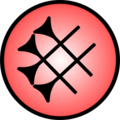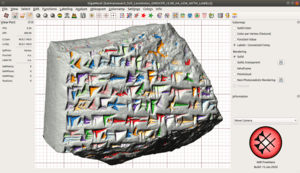GigaMesh Software Framework
The GigaMesh Software Framework is a free and open-source software for display, editing and visualization of 3D-data typically acquired with structured light or structure from motion[3].
 | |
 | |
| Developer(s) | Forensic Computational Geometry Laboratory (FCGL)[1], IWR, Heidelberg University |
|---|---|
| Stable release | 2005295[2]
/ 29 May 2020 |
| Repository | https://gitlab.com/fcgl/GigaMesh |
| Written in | C++ |
| Operating system | Linux and Windows 10 |
| Available in | 1 languages |
List of languages English | |
| Type | Graphics software |
| License | GPL |
| Website | gigamesh |
| Wikimedia Commons has media related to GigaMesh Software Framework. |
It provides numerous functions for analysis of archaeological objects like cuneiform tablets, ceramics[4][5] or converted LiDAR data.[6] Typically applications are unwrappings (or rollouts)[7], profile cuts (or cross sections)[8] as well as visualizations of distances and curvature, which can be exported as raster graphics or vector graphics.
The retrieval of text in 3D like damaged cuneiform tablets or weathered medieval headstones[9] using Multi Scale Integral Invariant (MSII)[10] filtering is a core function of the software. Furthermore small or faint surface details like fingerprints can be visualized.[11][12] The polygonal meshes of the 3D-models can be inspected, cleaned and repaired to provide optimal filtering results. The repaired datasets are suitable for 3D printing and for digital publishing in a dataverse.[13]
Name and logo
The name "GigaMesh" refers to processing of large 3D-datasets and relates intentional to the mythical sumerian king Gilgamesh and his heroic epic described on a set of clay tablets.[10]:115 The central element of the logo is the cuneiform sign 𒆜 (kaskal) meaning street or road junction, which symbolizes the intersection of the humanities and computer science. The surrounding circle refers to the integral invariant computation using a spherical domain. The red color is derived of carmine, the color used by the Heidelberg University, where GigaMesh is developed.
Development and application in research projects
The development began in 2009 and was inspired by the edition project Keilschrifttexte aus Assur literarischen Inhalts (KAL, cuneiform texts with literary content) of the Heidelberg Academy of Sciences and Humanities.[11] In parallel it was applied within the Austrian Corpus Vasorum Antiquorum of the Austrian Academy of Sciences for documentation of red-figure pottery.[8] Current projects are funded by the DFG and the BMBF for contextualization and analysis of seals and sealings of the Corpus der minoischen und mykenischen Siegel,[14][15] where Thin Plate Splines are used for comparing sealings.[16] Analog to the developments for processing cuneiform tablets there are further approaches for adaption of the combined Computer Vision and Machine Learning methods for other Scripts in 3D. An example is the application within the Text Database and Dictionary of Classic Mayan.[17]
In 2017 GigaMesh was tested by the DAI at an excavation in Guadalupe, near Trujillo, Honduras for immediate visualization of in-situ acquired findings with different 3D-scanners including a comparison with manual drawings.[18] Since then GigaMesh is permanently used by the excavation team. Their feedback lead to numerous improvements of the GUI as well as online tutorials with a focus on tasks required to compile excavation reports.
The Scanning for Syria (SfS)[19] project of the Leiden University used GigaMesh in 2018 for 3D reconstruction of molds of tablets lost in ar-Raqqa, Syria based on Micro-CT-scans.[20][21] As a follow-up project the TU Delft acquired further Micro-CT-scans for virtually extracting clay tablets still wrapped into clay envelopes, which are unopened for thousands of years.[22][23] In May 2020 the SfS project won the European Union Prize for Cultural Heritage of the Europa Nostra in the category research.[24]
A first version (190416) for Windows was released in preparation of presentations about new functions shown at the international CAA 2019[25].
The command line interface of GigaMesh is well suited to process large amounts of 3D-measurement data within repositories. This was demonstrated with almost 2.000 cuneiform tablets of the Hilprecht Collection of the Jena University, which were processed and digitally published as benchmarkdatabase (HeiCuBeDa)[26] for machine learning as well as database of images including 3D- and meta-data (HeiCu3Da)[27] using CC BY licenses.[28]
The Louvre showed GigaMesh based rollouts of an Aryballos from the collection of the KFU Graz representing the use of digital methods for research on pottery of ancient Greece within the CVA project, which had its 100th anniversary in 2019. Renderings of the rollouts were on display in the second half of 2019 in the display case named L’ère du numèrique et de l’imagerie scientifique (the digital era and scientific imaging).[29]
Version 191219 supports Texture maps common for 3D-data captured using photogrammetry. This allows processing and in particular unwrapping of objects acquired with Structure-from-Motion widely used for documentation of Cultural Heritage and in archaeology.
The Nara National Research Institute for Cultural Properties in Japan adapted GigaMesh for documentation and rollouts of vessels and published a tutorial[30], which was used to implement the workflow for ceramics of the Jōmon period within the Togariishi Museum of Jōmon Archaeology.[31]
In April 2020 the source code was published on GitLab and the license changed from freeware to the GPL.
References
- "FCGL: Forensic Computational Geometry Laboratory". fcgl.iwr.uni-heidelberg.de.
- "Gigamesh". gigamesh.eu.
- "An easy intro to 3D models from Structure from Motion (SFM, photogrammetry)". 2019-12-15. Retrieved 2020-04-10.
- Thaller, Manfred (2014-09-18). Are the Humanities an Endangered or a Dominant Species in the Digital Ecosystem?: An Interview. Proceedings of the Third AIUCD Annual Conference on Humanities and Their Methods in the Digital Ecosystem. ACM. pp. 1–6. doi:10.1145/2802612.2802613. ISBN 9781450332958.
- Pintus, Ruggero; Pal, Kazim; Yang, Ying; Weyrich, Tim; Gobbetti, Enrico; Rushmeier, Holly (2015-08-06). "A Survey of Geometric Analysis in Cultural Heritage". Computer Graphics Forum. 35 (1): 4–31. CiteSeerX 10.1.1.722.6692. doi:10.1111/cgf.12668. ISSN 0167-7055.
- Hämmerle, Martin; Höfle, Bernhard (2017-12-05), "Introduction to LiDAR in Geoarchaeology from a Technological Perspective", Natural Science in Archaeology, Springer International Publishing, pp. 167–182, doi:10.1007/978-3-319-25316-9_11, ISBN 9783319253145
- Bayer, Paul; Lamm, Susanne (2018), Trinkl, Elisabeth (ed.), "Mehr als nur Ben Hur – Eine 3D-Abrollung des römischen Silberbecher von Grünau", Forum Archaeologiae (in German), 87 (VI), ISSN 1605-4636
- Mara, Hubert; Portl, Julia (2013), Trinkl, Elisabeth (ed.), "Acquisition and Documentation of Vessels using High-Resolution 3D-Scanners" (PDF), Corpus Vasorum Antiquorum Österreich, Verlag der Österreichischen Akademie der Wissenschaften — VÖAW, Beiheft 1, pp. 25–40, ISBN 978-3-7001-7145-4, retrieved 2018-08-24, KBytes: 900
- Kurt F. de Swaaf (2010-06-30), "Gemeißelte Geheimnisse: Forscher entziffern jüdische Grabinschriften", Spiegel Online (in German), retrieved 2018-08-03
- Hubert Mara (2012), Multi-Scale Integral Invariants for Robust Character Extraction from Irregular Polygon Mesh Data, Heidelberg: Heidelberg University Library, doi:10.11588/heidok.00013890
- Mara, Hubert; Krömker, Susanne; Jakob, Stefan; Breuckmann, Bernd (2010), "GigaMesh and Gilgamesh — 3D Multiscale Integral Invariant Cuneiform Character Extraction", Proceedings of VAST International Symposium on Virtual Reality, Archaeology and Cultural Heritage, Palais du Louvre, Paris, France: Eurographics Association, pp. 131–138, doi:10.2312/VAST/VAST10/131-138, ISSN 1811-864X, retrieved 2019-06-23
- Hubert Mara (2017), Visual Computing for Analysis of Sealings, Script and Fingerprints in 3D, Presentation about Multi Scale Integral Invariant filtering with illustrating images (PDF), retrieved 2018-08-24, KBytes: 8700
- heiDATA — IWR Computer Graphics Dataverse in der Universitätsbibliothek Heidelberg
- "DFG - GEPRIS - Minoische Siegelglyptik zwischen corpusartiger Erfassung und 3D-Forensik. Eine multidisziplinäre Dokumentation von 900 unpublizierten Siegeln aus dem Archäologischen Museum von Heraklion" (in German). Retrieved 2018-09-11.
- "ErKon3D — Erschließung und Kontextualisierung von ägäischen Siegeln und Siegelabdrücken mit 3D-Forensik" (in German). Retrieved 2018-09-28.
- Bogacz, Bartosz; Papadimitriou, Nikolas; Panagiotopoulos, Diamantis; Mara, Hubert (2019), "Recovering and Visualizing Deformation in 3D Aegean Sealings", Proc. Of the 14th International Conference on Computer Vision Theory and Application (VISAPP), Prague, Czech Republic, retrieved 28 March 2019
- Feldmann, Felix; Bogacz, Bartosz; Prager, Christian; Mara, Hubert (2018), "Histogram of Oriented Gradients for Maya Glyph Retrieval", Proc. of the 16thEurographics Workshop on Graphics and Cultural Heritage (GCH), Vienna, Austria: The Eurographics Association, pp. 105–111, doi:10.2312/gch.20181346, ISBN 978-3-03868-057-4, ISSN 2312-6124, retrieved 2020-02-03
- Reindel, Markus; Fux, Peter; Fecher, Franziska (2018), "Archäologisches Projekt Guadalupe: Bericht über die Feldkampagne 2017", Jahresberichte (in German), Zürich, Switzerland: SLSA, Schweizerisch-Liechtensteinische Stiftung für archäologische Forschungen im Ausland, doi:10.5167/uzh-158145
- "Website of the Scanning for Syria project at the Leiden University". Retrieved 2019-11-27.
- Ngan-Tillard, Dominique (2018-06-05), Scanning for Syria - digital book of cuneiform tablet T98-34, Delft, Netherlands, doi:10.4121/uuid:0bd4470b-a055-4ebd-b419-a900d3163c8a, retrieved 2020-02-03, KBytes: 48600
- Nieuwenhuyse, Olivier; Hiatlih, Khaled; al-Fakhri, Ayham; Haqi, Rasha; Ngan-Tillard, Dominique; Mara, Hubert; Burch Joosten, Katrina (2019), "Focus Raqqa: Schutz für das archäologische Erbe des Museums von ar-Raqqa", Antike Welt (in German), wbg Philipp von Zabern, pp. 76–83, retrieved 2019-12-17
- Seeing through clay: 4000 year old tablets in hypermodern scanner on YouTube
- Unpacking a Cuneiform Tablet wrapped in a clay envelop on YouTube, cf. doi:10.11588/heidok.00026892
- "Website of the Europa Nostra Award for the Scanning for Syria project". Retrieved 2020-05-07.
- "International Conference on Computer Applications and Quantitive Methods in Archaeology, Krakau, Poland, 2019". Retrieved 2019-04-16.
- Mara, Hubert (2019-06-07), HeiCuBeDa Hilprecht – Heidelberg Cuneiform Benchmark Dataset for the Hilprecht Collection, heiDATA – institutional repository for research data of Heidelberg University, doi:10.11588/data/IE8CCN
- Mara, Hubert (2019-06-07), HeiCu3Da Hilprecht – Heidelberg Cuneiform 3D Database - Hilprecht Collection, heidICON – Die Heidelberger Objekt- und Multimediadatenbank, doi:10.11588/heidicon.hilprecht
- Mara, Hubert; Bogacz, Bartosz (2019), "Breaking the Code on Broken Tablets: The Learning Challenge for Annotated Cuneiform Script in Normalized 2D and 3D Datasets", Proceedings of the 15th International Conference on Document Analysis and Recognition (ICDAR), Sydney, Australia, doi:10.1109/ICDAR.2019.00032
- "IWR Newsroom, Contribution of visualizations to an archaeological Exhibition in the Louvre Museum". 2019-07-13. Retrieved 2020-01-31.
- "文化財の壺 第7号 特集:文化財研究を進める技術を考える, Issue 7, June 2019, ISBN 21851972" (in Japanese). Retrieved 2020-04-10.
- Araki Minoru (2020-01-30). "Blog entry about rollouts of Jōmon period vessels in Nara" (in Japanese). Retrieved 2020-01-31.
External links
- GigaMesh.eu - website of the GigaMesh Software Frameworks including tutorials, publications and downloads
- ResearchGate - additional project website and blog